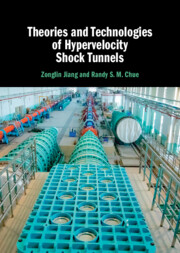Book contents
- Theories and Technologies of Hypervelocity Shock Tunnels
- Theories and Technologies of Hypervelocity Shock Tunnels
- Copyright page
- Contents
- Preface
- 1 Introduction
- 2 Shock-Wave Relations and Aerothermodynamic States
- 3 Heated Light-Gas High-Enthalpy Shock Tunnels
- 4 Free-Piston-Driven High-Enthalpy Shock Tunnels
- 5 Detonation-Driven High-Enthalpy Shock Tunnels
- 6 Theory and Methods for Long-Test-Duration Shock Tunnels
- 7 Methods for Designing High-Enthalpy Flow Nozzles
- 8 Aerothermodynamic Testing and Hypersonic Physics
- Index
- References
4 - Free-Piston-Driven High-Enthalpy Shock Tunnels
- Theories and Technologies of Hypervelocity Shock Tunnels
- Theories and Technologies of Hypervelocity Shock Tunnels
- Copyright page
- Contents
- Preface
- 1 Introduction
- 2 Shock-Wave Relations and Aerothermodynamic States
- 3 Heated Light-Gas High-Enthalpy Shock Tunnels
- 4 Free-Piston-Driven High-Enthalpy Shock Tunnels
- 5 Detonation-Driven High-Enthalpy Shock Tunnels
- 6 Theory and Methods for Long-Test-Duration Shock Tunnels
- 7 Methods for Designing High-Enthalpy Flow Nozzles
- 8 Aerothermodynamic Testing and Hypersonic Physics
- Index
- References
Summary
The free-piston driver is a powerful technique to increase both the driver gas sound speed and pressure. Therefore, it is capable of generating high-enthalpy flows and offering high performance among various gasdynamic shock drivers. So far, it has been implemented in a number of major reflected-shock as well as shock-expansion wind tunnels around the world. The free-piston driver has the advantage that a high driver gas pressure is automatically generated in the same process. On the other hand, the driver is far more complex mechanically and requires operation-tuning in order to operate effectively. Moreover, its test time is short and the test flow is not steady because the piston motion is difficult to control. In this chapter, the basic concepts of the free-piston driver are discussed. The analytical theory that describes the piston dynamics and the method for tuned piston operation are presented. Examples of major free-piston-driven test facilities as well as their applications in hypersonic testing are also summarized.
Keywords
- Type
- Chapter
- Information
- Theories and Technologies of Hypervelocity Shock Tunnels , pp. 73 - 118Publisher: Cambridge University PressPrint publication year: 2023



